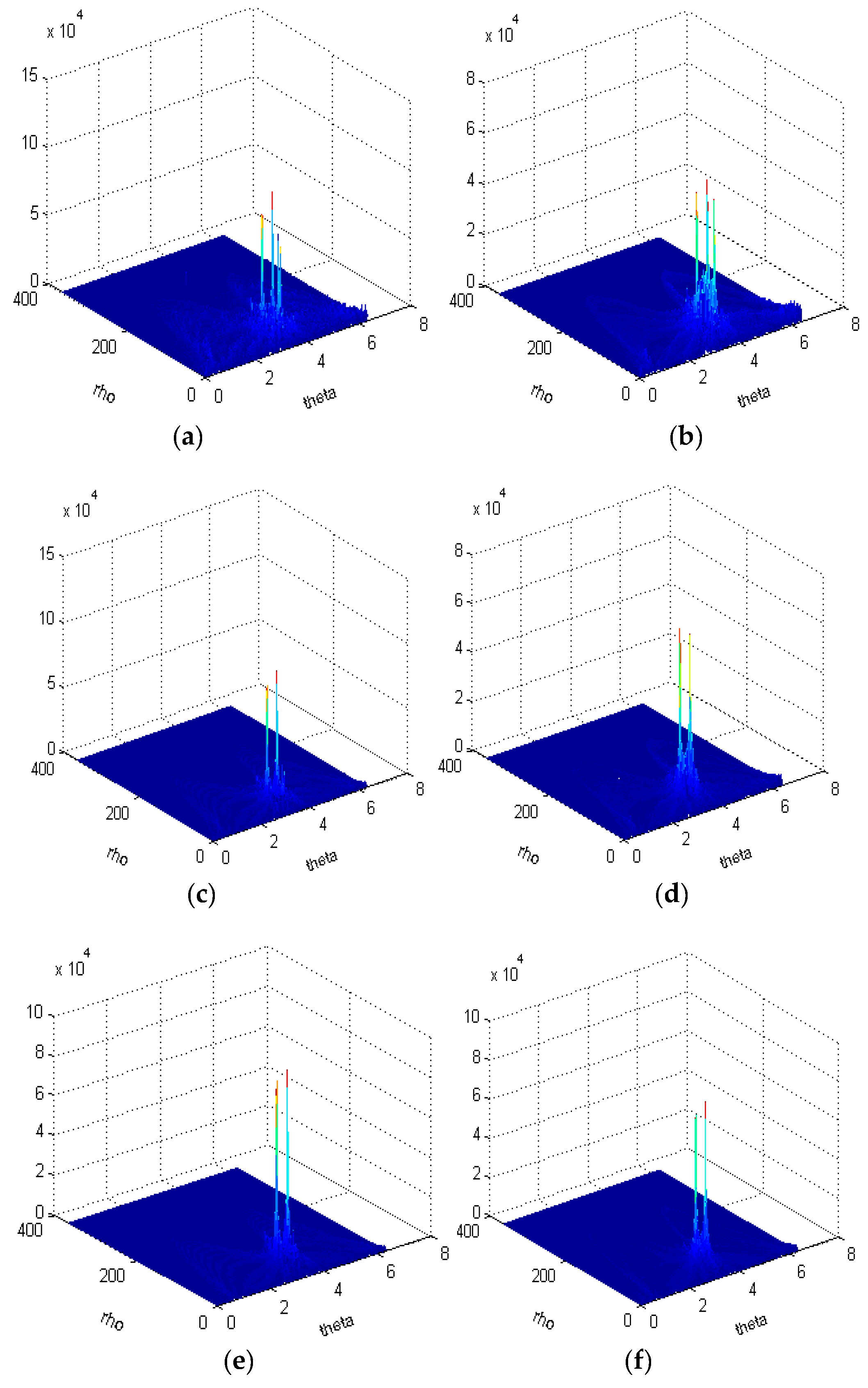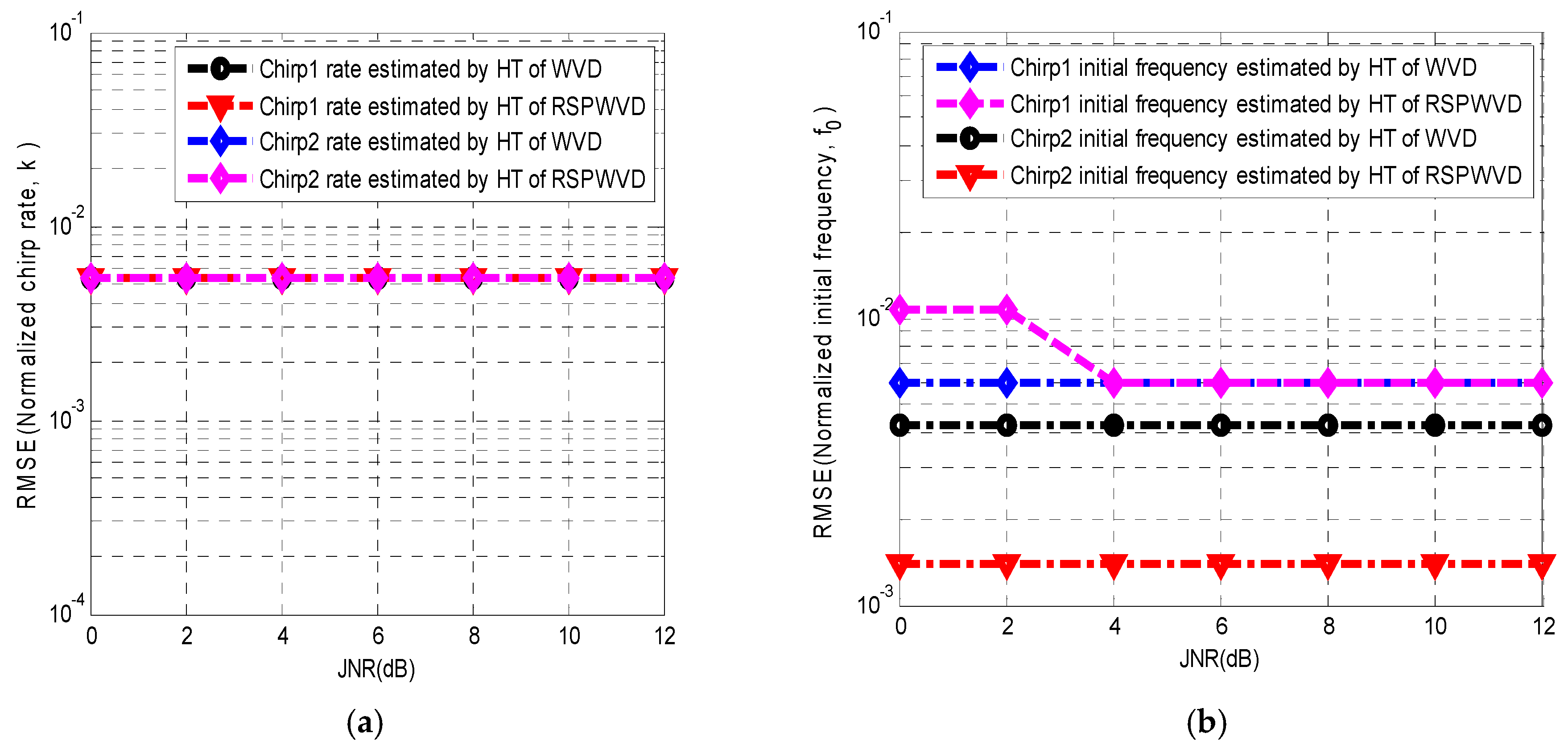A Joint Method Based on Time-Frequency Distribution to Detect Time-Varying Interferences for GNSS Receivers with a Single Antenna
Abstract
:1. Introduction
2. Signal and System Model
- is the received GNSS signal power from the lth satellite;
- is the pseudorandom noise sequence, and is the code phase delay;
- is the navigation data message signal;
- is GNSS signal intermediate frequency;
- is the Doppler-affected frequency;
- is the carrier phase delay.
- is the power of the mth jamming signal;
- is the mth jamming instantaneous frequency;
- is the phase delay of the mth jamming signal;
- is the number of interferences.
3. The Proposed Method
3.1. Hough Transform
3.2. The Combination of WVD and Hough Transform
3.3. Double Threshold Detection
3.4. Joint Method Based on Hough Transform of RSPWVD
- map onto the TF plane by computing its RSPWVD
- separate the data of into two sets and map the set above the primary threshold onto the Hough transform.
- search the peaks of ; if a peak exceeds the secondary threshold, record its point value
- estimate the parameter by the point value
3.5. Impact on the Acquisition Stage
4. Results
5. Conclusions
Author Contributions
Funding
Conflicts of Interest
References
- Grabowski, J. Personal privacy jammers: Locating jersey PPDs jamming GBAS safety-of-life signals. GPS World 2012, 23, 28–37. [Google Scholar]
- Marcos, E.P.; Konovaltsev, A.; Caizzone, S.; Cuntz, M.; Yinusa, K.; Elmarissi, W.; Meurer, M. Interference and Spoofing Detection for GNSS Maritime Applications using Direction of Arrival and Conformal Antenna Array. In Proceedings of the 31st International Technical Meeting of the Satellite Division of the Institute of Navigation, ION GNSS+ 2018 Conference, Miami, FL, USA, 24–28 September 2018. [Google Scholar]
- Son, P.W.; Rhee, J.H.; Seo, J. Novel Multichain-Based Loran Positioning Algorithm for Resilient Navigation. IEEE Trans. Aerosp. Electron. Syst. 2018, 54, 666–679. [Google Scholar] [CrossRef]
- Motella, B.; Pini, M.; Dovis, F. Investigation on the effect of strong out-of-band signals on global navigation satellite systems receivers. GPS Solut. 2008, 12, 77–86. [Google Scholar] [CrossRef]
- Fu, Z.; Hornbostel, A.; Hammesfahr, J.; Konovaltsev, A. Suppression of multipath and jamming signals by digital beamforming for GPS/Galileo applications. GPS Solut. 2003, 6, 257–264. [Google Scholar] [CrossRef]
- Palestini, C.; Pedone, R.; Villanti, M.; Corazza, G. Integrated NAV-COM Systems: Assisted Code Acquisition and Interference Mitigation. IEEE Syst. J. 2008, 2, 48–61. [Google Scholar] [CrossRef]
- Capozza, P.; Holland, B.; Hopkinson, T.; Landrau, R. A single-chip narrow-band frequency-domain excisor for a Global Positioning System (GPS) receiver. IEEE J. Solid State Circuits 2000, 35, 401–411. [Google Scholar] [CrossRef] [Green Version]
- Auger, F.; Flandrin, P. Improving the readability of time–frequency and time-scale representations by the reassignment method. IEEE Trans. Signal Process. 1995, 43, 1068–1089. [Google Scholar] [CrossRef]
- Savasta, S.; Presti, L.; Rao, M. Interference Mitigation in GNSS Receivers by a Time-Frequency Approach. IEEE Trans. Aerosp. Electron. Syst. 2013, 49, 415–438. [Google Scholar] [CrossRef]
- Dovis, F. GNSS Interference Threats and Countermeasures; Artech House: Norwood, MA, USA, 2015. [Google Scholar]
- Betz, J.W. Effect of Partial-Band Interference on Receiver Estimation of C/N0: Theory. In Proceedings of the 2001 National Technical Meeting of the Institute of Navigation, Long Beach, CA, USA, 22–24 January 2001. [Google Scholar]
- Bastide, F.; Akos, D.; Macabiau, C.; Roturier, B. Automatic Gain Control (AGC) as an Interference Assessment Tool. In Proceedings of the 16th International Technical Meeting of the Satellite Division of The Institute of Navigation, ION GNSS2003, Portland, OR, USA, 9–12 September 2003. [Google Scholar]
- Lv, Q.S.; Qin, H.L. A novel algorithm for adaptive notch filter to detect and mitigate the CWI for GNSS receivers. In Proceedings of the ICSIP2018, Shenzhen, China, 13–15 July 2018. [Google Scholar]
- Jin, T.; Ren, J. Stability analysis of GPS carrier tracking loops by phase margin approach. GPS Solut. 2013, 17, 423–431. [Google Scholar] [CrossRef]
- Chen, Y.H.; Juang, J.C.; Seo, J.; Lo, S.; Akos, D.M.; Lorenzo, D.S.D.; Enge, P. Design and Implementation of Real-Time Software Radio for Anti-Interference GPS/WAAS Sensors. Sensors 2012, 12, 13417–13440. [Google Scholar] [CrossRef] [PubMed] [Green Version]
- Park, K.; Lee, D.; Seo, J. Dual-polarized GPS antenna array algorithm to adaptively mitigate a large number of interference signals. Aerosp. Sci. Technol. 2018, 78, 387–396. [Google Scholar] [CrossRef]
- Zhang, L.; Li, B.; Huang, L.; Kirubarajan, T.; So, H.C. Robust minimum dispersion distortionless response beamforming against fast-moving interferences. Signal Process. 2017, 140, 190–197. [Google Scholar] [CrossRef]
- Lv, Q.S.; Qin, H.L. An improved method based on time-frequency distribution to detect time-varying interference for GNSS receivers with single antenna. IEEE Access 2019, 7, 38608–38617. [Google Scholar] [CrossRef]
- Hlawatsch, F.; Auger, F. Time-Frequency Analysis; Wiley Press: Hoboken, NJ, USA, 2005. [Google Scholar]
- Cohen, L. Time-Frequency Analysis: Theory and Applications; Prentice-Hall Press: Upper Saddle River, NJ, USA, 1995. [Google Scholar]
- Hough, P. Method and Means for Recognizing Complex Patterns. U.S. Patent 3069654, 1962. [Google Scholar]
- Barbarossa, S. Analysis of Multicomponent LFM Signals by a Combined Wigner-Hough Transform. IEEE Trans. Signal Process. 1995, 43, 1511–1515. [Google Scholar] [CrossRef]
- Barbarossa, S.; Scaglione, A. Adaptive time-varying cancellation of wideband interferences in spread-spectrum communications based on time-frequency distributions. IEEE Trans. Signal Process. 1999, 47, 957–965. [Google Scholar] [CrossRef] [Green Version]
- Moshe, E. Search Radar Track-Before-Detect Using the Hough Transform. Master’s Thesis, Naval Postgraduate School Monterey, Monterey, CA, USA, 1995. [Google Scholar]
- Henttu, P.; Aromaa, S. Consecutive mean excision algorithm. In Proceeding of the IEEE 7th International Symposium on Spread Spectrum Techniques and Application, Prague, Czech Republic, 2–5 September 2002. [Google Scholar]
- Vartiainen, J. Concentrated Signal Extraction Using Consecutive Mean Excision Algorithms. Ph.D. Thesis, University of Oulu, Oulu, Finland, 2010. [Google Scholar]
- Borio, D. GNSS Acquisition in the Presence of Continuous Wave Interference. IEEE Trans. Aerosp. Electron. Syst. 2010, 46, 47–60. [Google Scholar] [CrossRef] [Green Version]







| Parameter | Value |
|---|---|
| Bandwidth | 20 MHz |
| Intermediate frequency | 40 MHz |
| Down Converter Gain | 60 dB |
| Dynamic range in Down Converter | 70 dB |
| Sampling Rates | 200 MHz |
| Bits Per sample | 14 |
| Sweep Period (us) | Estimation of Initial Frequency RMSE (Normalized) | Estimation of Chirp Rate RMSE (Normalized) |
|---|---|---|
| 2.56 | 0.005438 | 0.005941 |
| 5.12 | 0.015086 | 0.006581 |
| 10.24 | 0.017463 | 0.007522 |
| Method | Computational Requirements |
|---|---|
| WVD | complex multiplications complex additions |
| RSPWVD | complex multiplications complex additions |
| WVD + Hough | complex multiplications complex additions |
| RSPWVD + Hough | complex multiplications complex additions |
© 2019 by the authors. Licensee MDPI, Basel, Switzerland. This article is an open access article distributed under the terms and conditions of the Creative Commons Attribution (CC BY) license (http://creativecommons.org/licenses/by/4.0/).
Share and Cite
Lv, Q.; Qin, H. A Joint Method Based on Time-Frequency Distribution to Detect Time-Varying Interferences for GNSS Receivers with a Single Antenna. Sensors 2019, 19, 1946. https://doi.org/10.3390/s19081946
Lv Q, Qin H. A Joint Method Based on Time-Frequency Distribution to Detect Time-Varying Interferences for GNSS Receivers with a Single Antenna. Sensors. 2019; 19(8):1946. https://doi.org/10.3390/s19081946
Chicago/Turabian StyleLv, Qingshui, and Honglei Qin. 2019. "A Joint Method Based on Time-Frequency Distribution to Detect Time-Varying Interferences for GNSS Receivers with a Single Antenna" Sensors 19, no. 8: 1946. https://doi.org/10.3390/s19081946





